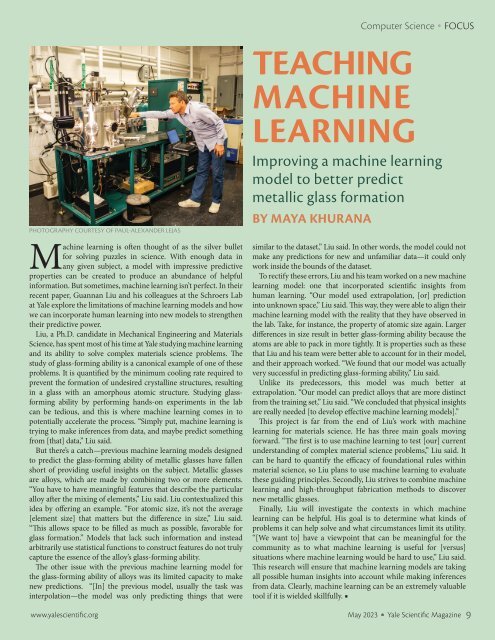YSM Issue 96.2
You also want an ePaper? Increase the reach of your titles
YUMPU automatically turns print PDFs into web optimized ePapers that Google loves.
Computer Science<br />
FOCUS<br />
TEACHING<br />
MACHINE<br />
LEARNING<br />
PHOTOGRAPHY COURTESY OF PAUL-ALEXANDER LEJAS<br />
Machine learning is often thought of as the silver bullet<br />
for solving puzzles in science. With enough data in<br />
any given subject, a model with impressive predictive<br />
properties can be created to produce an abundance of helpful<br />
information. But sometimes, machine learning isn’t perfect. In their<br />
recent paper, Guannan Liu and his colleagues at the Schroers Lab<br />
at Yale explore the limitations of machine learning models and how<br />
we can incorporate human learning into new models to strengthen<br />
their predictive power.<br />
Liu, a Ph.D. candidate in Mechanical Engineering and Materials<br />
Science, has spent most of his time at Yale studying machine learning<br />
and its ability to solve complex materials science problems. The<br />
study of glass-forming ability is a canonical example of one of these<br />
problems. It is quantified by the minimum cooling rate required to<br />
prevent the formation of undesired crystalline structures, resulting<br />
in a glass with an amorphous atomic structure. Studying glassforming<br />
ability by performing hands-on experiments in the lab<br />
can be tedious, and this is where machine learning comes in to<br />
potentially accelerate the process. “Simply put, machine learning is<br />
trying to make inferences from data, and maybe predict something<br />
from [that] data,” Liu said.<br />
But there’s a catch—previous machine learning models designed<br />
to predict the glass-forming ability of metallic glasses have fallen<br />
short of providing useful insights on the subject. Metallic glasses<br />
are alloys, which are made by combining two or more elements.<br />
“You have to have meaningful features that describe the particular<br />
alloy after the mixing of elements,” Liu said. Liu contextualized this<br />
idea by offering an example. “For atomic size, it’s not the average<br />
[element size] that matters but the difference in size,” Liu said.<br />
“This allows space to be filled as much as possible, favorable for<br />
glass formation.” Models that lack such information and instead<br />
arbitrarily use statistical functions to construct features do not truly<br />
capture the essence of the alloy’s glass-forming ability.<br />
The other issue with the previous machine learning model for<br />
the glass-forming ability of alloys was its limited capacity to make<br />
new predictions. “[In] the previous model, usually the task was<br />
interpolation—the model was only predicting things that were<br />
www.yalescientific.org<br />
Improving a machine learning<br />
model to better predict<br />
metallic glass formation<br />
BY MAYA KHURANA<br />
similar to the dataset,” Liu said. In other words, the model could not<br />
make any predictions for new and unfamiliar data—it could only<br />
work inside the bounds of the dataset.<br />
To rectify these errors, Liu and his team worked on a new machine<br />
learning model: one that incorporated scientific insights from<br />
human learning. “Our model used extrapolation, [or] prediction<br />
into unknown space,” Liu said. This way, they were able to align their<br />
machine learning model with the reality that they have observed in<br />
the lab. Take, for instance, the property of atomic size again. Larger<br />
differences in size result in better glass-forming ability because the<br />
atoms are able to pack in more tightly. It is properties such as these<br />
that Liu and his team were better able to account for in their model,<br />
and their approach worked. “We found that our model was actually<br />
very successful in predicting glass-forming ability,” Liu said.<br />
Unlike its predecessors, this model was much better at<br />
extrapolation. “Our model can predict alloys that are more distinct<br />
from the training set,” Liu said. “We concluded that physical insights<br />
are really needed [to develop effective machine learning models].”<br />
This project is far from the end of Liu’s work with machine<br />
learning for materials science. He has three main goals moving<br />
forward. “The first is to use machine learning to test [our] current<br />
understanding of complex material science problems,” Liu said. It<br />
can be hard to quantify the efficacy of foundational rules within<br />
material science, so Liu plans to use machine learning to evaluate<br />
these guiding principles. Secondly, Liu strives to combine machine<br />
learning and high-throughput fabrication methods to discover<br />
new metallic glasses.<br />
Finally, Liu will investigate the contexts in which machine<br />
learning can be helpful. His goal is to determine what kinds of<br />
problems it can help solve and what circumstances limit its utility.<br />
“[We want to] have a viewpoint that can be meaningful for the<br />
community as to what machine learning is useful for [versus]<br />
situations where machine learning would be hard to use,” Liu said.<br />
This research will ensure that machine learning models are taking<br />
all possible human insights into account while making inferences<br />
from data. Clearly, machine learning can be an extremely valuable<br />
tool if it is wielded skillfully. ■<br />
May 2023 Yale Scientific Magazine 9

















